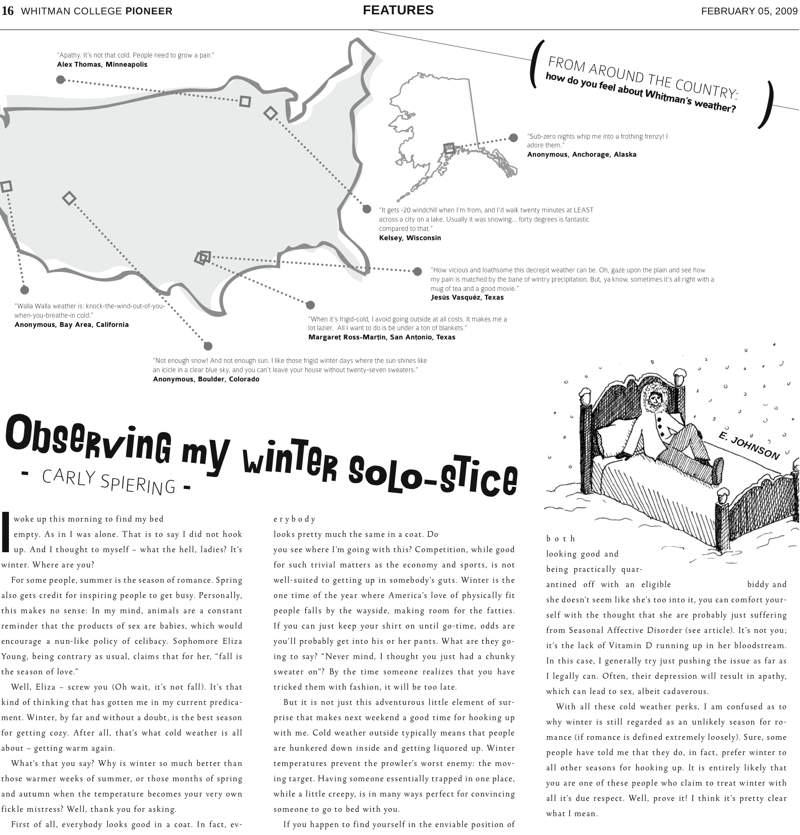This article is part of the Featured section. See how it originally look in print by clicking on one of the images below. Article continues below photos.
Most Whitman students yearn for the sun in the long winter months, but for those suffering from Seasonal Affective Disorder, the absence of sunshine can become a hindrance to their ability to function normally.
Seasonal Affective Disorder, commonly referred to as SAD, is a mood disorder that describes the onset of depression during winter in people who have otherwise normal mental health. Associate Dean of Students for health and wellness Richard Jacks categorizes SAD as “recurring low-grade depression.” However, SAD can take on more serious forms, especially if it is left untreated.
People diagnosed with SAD typically have little energy, sleep too much and crave sugary foods during the fall and winter. Junior Mia Huth began to suspect she had SAD after learning about the disorder in her psychology
class. “I have little energy to do things. The short days and lack of sunshine feel oppressive, almost suffocating,” she said.
Research shows that seasonal depression is linked with the change in the amount of sunlight. SAD was first diagnosed by Norman Rosenthal in 1984 and it has since been estimated that nearly ten million Americans have the disorder.
One of the most effective ways to combat winter depression is to use a full spectrum lamp. These bright lights mimic sunlight, thereby stimulating the system to release the neurotransmitter serotonin. By sitting in front of the lamp for thirty minutes each morning, SAD sufferers can relieve their symptoms.
The counseling center purchased a full spectrum lamp for student use approximately fifteen years ago. “Each year there will be half a dozen people who end up using it on a regular basis,” said Jacks. He also said that students frequently end up buying their own light after experiencing its benefits at the counseling center.
The effects of the full spectrum lamp can be almost immediate. “The days I use it are good days, and the days I don’t use it are bad days. It’s almost that big of a difference,” said junior Christopher Tobin-Campbell of his lamp.
Full spectrum lamps can also be used to treat other circadian rhythm – related disorders. Sophomore Paul Butler was diagnosed about a year ago with delayed sleep phase syndrome, which he describes as “a disorder where my circadian rhythm is offset by eight hours.” In effect, Butler has a normal need to sleep, but if left untreated will naturally fall asleep at six o’clock in the morning.
To combat his disorder, Butler uses blue-blocking glasses in addition to the full spectrum lamp. These specialized glasses are worn at night before bed time to block out artificial lights, thereby helping to induce tiredness at the correct time of day.
Butler was the only student of those interviewed who had been officially diagnosed with a disorder. With awareness of seasonal affective disorder on the rise, self-diagnosis is becoming more prevalent.
“Every winter my mood goes down. Whether or not I’m officially diagnosed doesn’t really matter to me,” said junior Harrison Fulop.
Tobin-Campbell was optimistic about the ability of the full spectrum lamp to help almost anyone who feels sad in the winter. “To some extent, most people get affected by the seasons,” said Tobin-Campbell.
Exercise, especially through sports or other outdoor activities, can be a key component in combating the tendency to withdraw associated with SAD. For those suffering from SAD, the mere act of being outdoors can be a relief. “Even when it’s gray, I still try to be outside for as long as possible,” said Huth.
Jacks reinforced the idea that general health practices can help reduce the symptoms of SAD, advising students to “get plenty of sleep, exercise, eat well, take good care of yourself: do nice things for yourself.”
A final recommendation for managing the winter blues is to remain optimistic no matter what the weather and avoid the psychological effect of self-diagnosis.
“Now that I have kind of labeled myself, I get up in the morning and see that it’s cloudy and I’m like ‘Okay, it’s gonna be a bad day,'” said Fulop.







